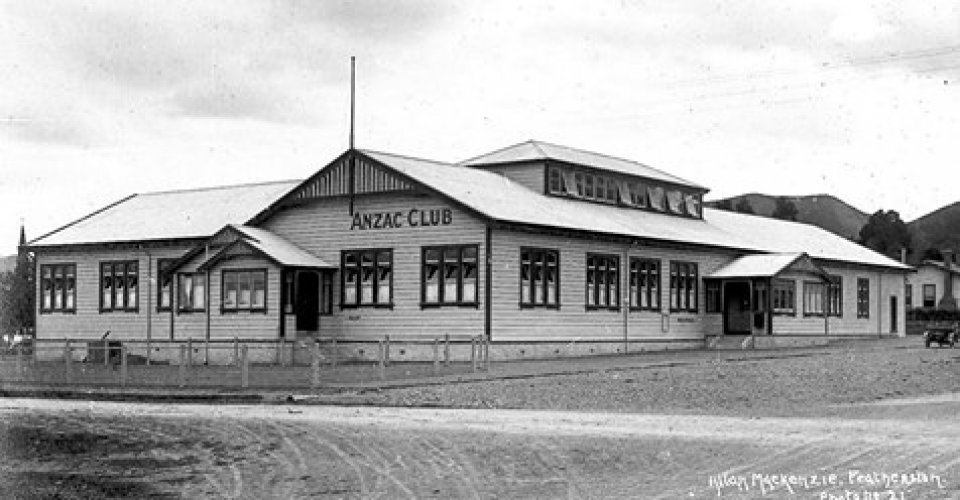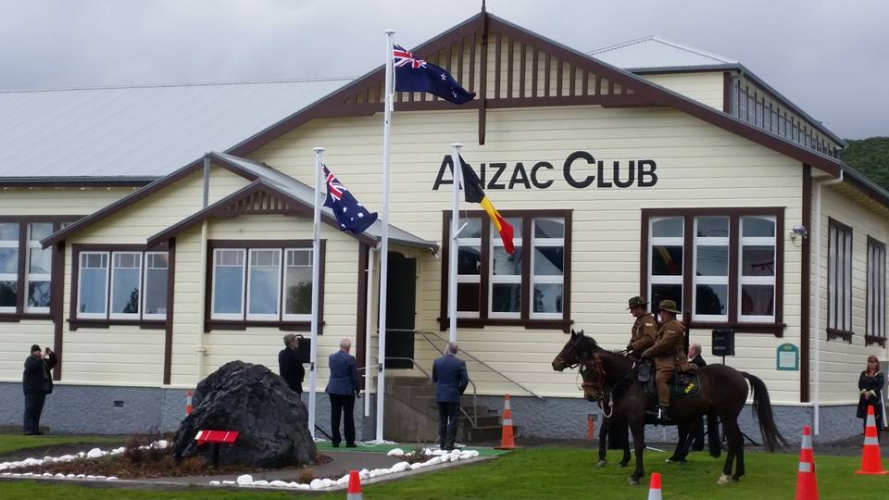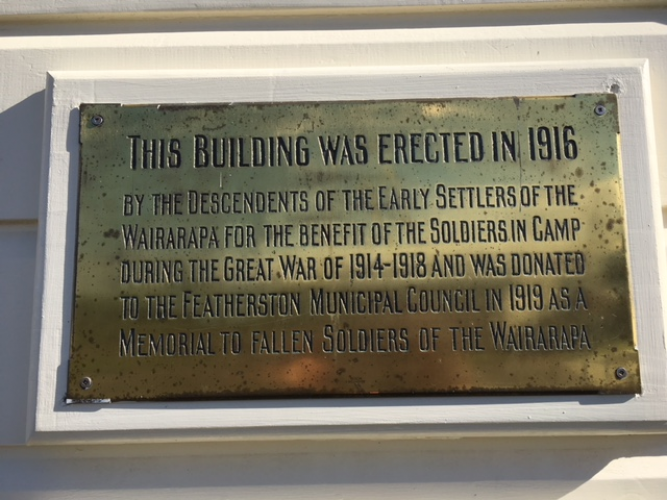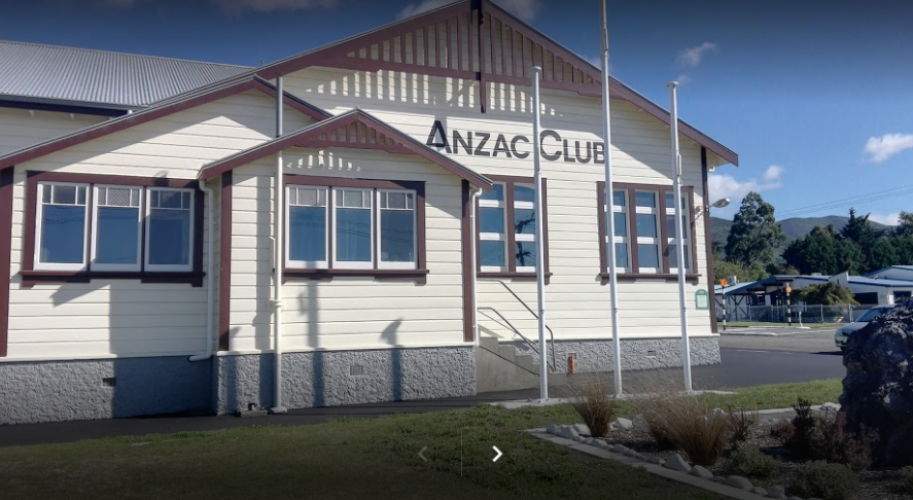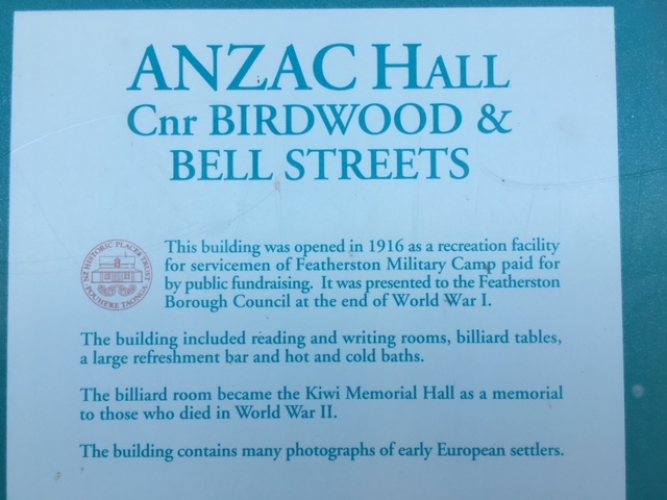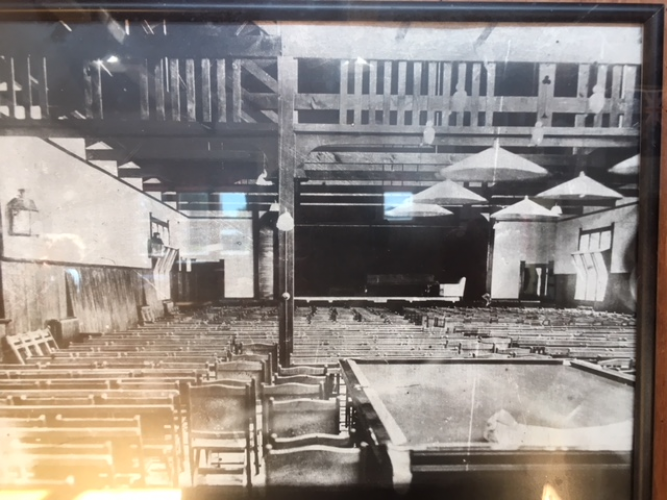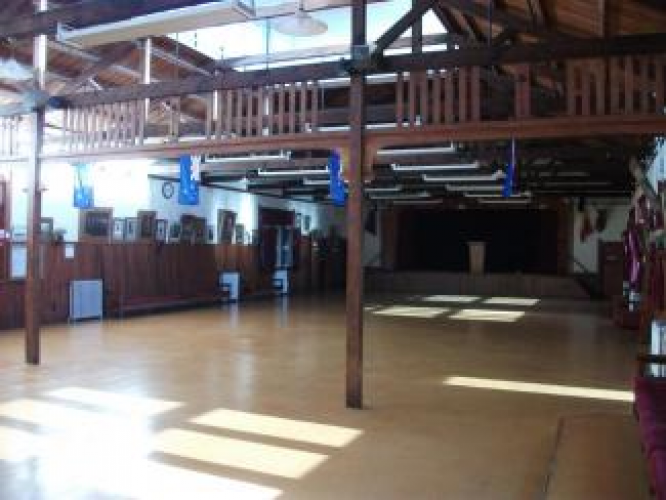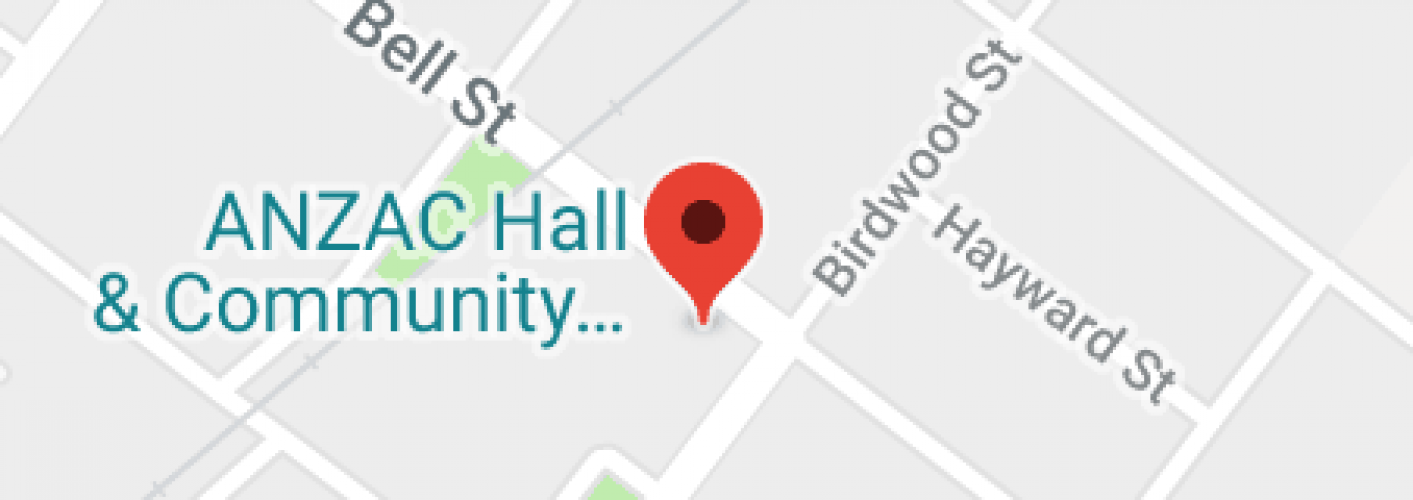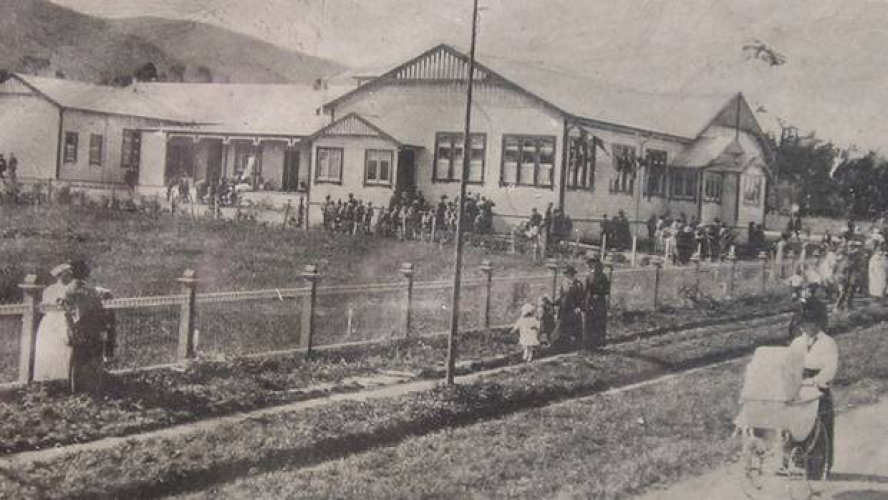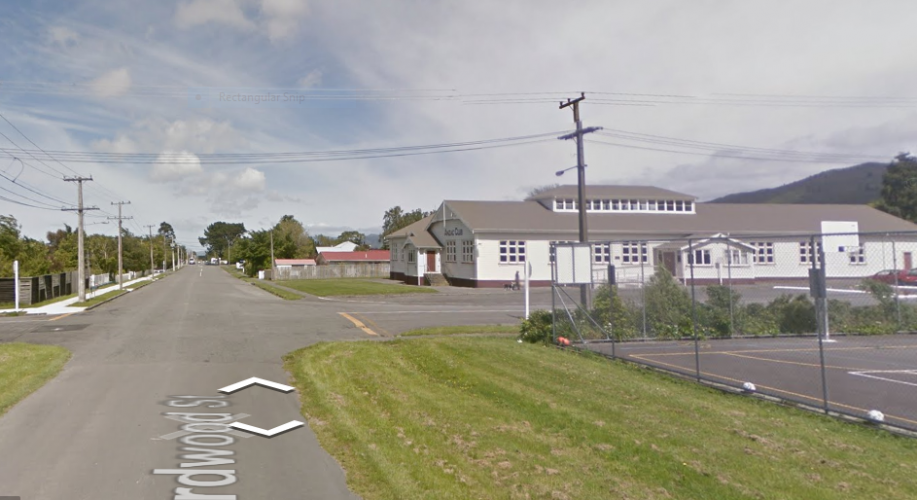110 ANZAC Hall Featherston, street scene ANZAC Hall 2017
Reason for the name
The Solider’s Club in Featherston was built to recognise the brave sacrifice of those who were fighting for their country, and the world. At this time in World War One the Gallipoli campaign was the only fighting that New Zealanders had been involved in. The Anzacs had just been evacuated from Anzac Cove at the end of 1915 and this is possibly why the club was named the Anzac Club.
This Poppy Place tells the story of an impressive well maintained hall in Featherston that was specifically built to recognise the sacrifices made by our soldiers in Gallipoli
Authors: Isaac Burt, Jasmyn Hall, Courtney Pomeroy, Asta Lanceley-Stokes (Students at St Teresa’s School), Carrie Watson (Teacher)
Thanks to Elsa Kelly from Featherston Hertitage Museum for sourcing the Wairarapa Times Age articles for us and to Lesley Wardle and Neil Frances for the information that they shared with us.
The Anzac Club was built on 16 October 1916 It is the last remaining building connected with the former Featherston Military Camp and it is now a Category 1 historic place, registered by the NZ Historic Places Trust in 1987.
A group of the original families to Featherston decided to build a soliders club to recognise the brave sacrifice of the young men who were fighting for their country and for the world. They donated money and then got donations from other families, and quickly raised 10,000 pounds. This list shows the people who made donations and the amounts that they made:
Original Subscribers to the Soldiers Club (Source: The Anzac Club Story by John Tenquist, 2002)
£300
Barton, William
Beetham, Hugh
Fareham, Featherston
Brancepeth, Masterton
Beetham, William N Masterton
Bidwill, JO Pihautea, Featherston
Bidwill, WE Rototawai, Featherston
Booth, W Howard Carterton
Buchanan, Hon Sir WC Tupurupuru
Elgar, Charles Fernside, Featherston
Kebbell, WM Erige, Masterton
Martin, A Otaraia, Martinborough
Martin, J Martinborough
Martin, WJ Martinborough
Matthews, A Waiorongomai, Featherston
McMaster, J Tuhitarata, Featherston
Morrison, Hugh Awatoitoi, Masterton
Pain, George Martinborough
Riddiford, DHS Longwood, Featherston
Riddiford, Eric L Orongorongo, Wainuiomata/Wairarapa
Riddiford, E Vivian Woburn, Lower Hutt
Hall, F Martinborough
Armstrong, F Akitio, Pongaroa/Wairarapa
£169
Bunny, OA Waipipi, Masterton
Donald, Mrs J Featherston
Holmes, EC Masterton
Speedy, Bruce Featherston
Tocker, Arthur Tauherenikau , Featherston
Toogood, AJ Featherston
£150
Hume, George Tauanui, Pirinoa
Hume, William Rahoruru, Pirinoa
£100
Bidwill, CR Tawaha, Featherston
Bidwill, JC Te Maire, Featherston
Card, JW Featherston
Johnston, Walter G Wellington
Kebbell, Cecil R Te Hoe, Alfredton
McLeod, AD Martinborough
Sutherland, D Ngiapua, Hinakura
Tyer, AG Featherston
£184
Donald, Allen Tarureka, Featherston
Donald Quentin Tarureka, Featherston
£50
Barton, Roy N Ongaha, Featherston
Bunny, Henry Robert Ahiaruhe, Carterton
Clark, Archibald Featherston
Collins, David Charles Te Kopura, Featherston
Cundy, Samuel Featherston
Elgar, Martin Fernside , Featherston
Hutton, George Ruatahuna, Martinborough
Martin, Walter Puritanga, Martinborough
Cameron, Ian Hinakura, Martinborough
Matthews, Chas. Oporua, Featherston
Matthews, N Wharepapa, Featherston
Matthews, Ray Waiorongomai, Featherston
Matthews, HA Papatahi, Featherston
McMaster, AO Matawhero, Featherston
Moore, George Eparaima, Homewood
Pearce, A Campbell Otahuna, Featherston
Pearce, Neil Tahora, Featherston
Perry, William Masterton
Smith, Robert Martinborough
Smith, Stephen Martinborough
Wardell, William Te Whiti, Masterton
Strang, J Gladstone
The building cost $3,500 it was opened on 16 October 1916 by Sir James Allen.
Most of the money was spent on building the things they thought the soldiers would need like reading and writing rooms, a concert hall, baths, card and billiard tables and a cafeteria. During the influenza epidemic in November-December 1918 the Anzac Club served as a temporary hospital.
In 1919 the people voted to gift the Club to the Featherston Municipal Council as a Memorial to the Wairarapa Soldiers who were killed in the Great War. The town used it as a Hall but in the Second World War it was used as a hospital again to care for the Japanese soldiers who were wounded in the incident on 25 February 1943.
There was some money left over so the people wanted to build a War Memorial next to the Anzac Club, but it was eventually built in the middle of the town.
In 1949 Cr A D Johnson proposed that the Officer’s rooms in the Anzac Hall Complex be converted into a hall as a memorial to the soldiers of World War II, this eventually happened in 1950, and was officially opened on 26 October 1950. This is what we know as the Kiwi Hall.
The following articles appeared in the Wairarapa Times Age:
Opening of the Kiwi Hall on the 26 October 1950
KIWI HALL, FEATHERSTON,
OFFICIAL OPENING.
RESIDENTS of the Featherston District are cordially invited to attend the official opening of the Kiwi Hall, Featherston, which will take place at 8 p.m. on THURSDAY, October 26, 1950. The opening ceremony will be followed by supper and dancing.
F. WHITE,
Mayor.
Wairarapa Times Age 25 October 1950
FEATHERSTON
TOWN AFFAIRS
OPENING OF KIWI HALL
("Times-Age" Special.)
The Featherston Borough Council met last evening, there being present the Mayor, Mr F. White, and Councillors R. Donald, C. C. Kenward, N. C. C. Shepherd, G. A. Farrier, F. W. Smith, A. D. Johnston and E. H. Edge.
Members stood in silence as a mark of respect to the late Mrs A. W. Horton, Mayoress of Greytown. The Town Clerk was instructed to send a letter of condolence to the Mayor of Greytown.
The borough foreman reported that the footpaths had been formed and metalled in Fitzherbert and Birdwood streets.
The Featherston R.S.A. wrote offering to supply a new drop curtain for the Anzac Hall stage, in recognition of the good treatment it had received from the council in the past.
Permission was given to the R.S.A. to conduct a street appeal for the nurses' memorial fund on Friday, October 27.
The date for the opening of the Kiwi Hall was fixed for Thursday, October 26, when a social and dance would follow the official ceremony and the unveiling of the roll of honour for the Second World War.
The Anzac Hall was 100 years old on 16 October 2016. There has been some restoration done in the hall, but many of the original features are still there. The town celebrated the centenary with a family picnic, a special ceremony with the Governor-General and a dance. A commemorative rock from the Rimutaka Hill was placed outside the hall. This is to remember all the troops who trained at the Featherston Military Camp who marched over the hill before going off to war. Students from our school painted the white rocks that sit around the edge of the garden. These were to represent the white stones used at the Featherston Military Camp.
In 2018 the Anzac Hall is used by lots of different groups. Our school uses it for our productions and graduations but it is also used for visiting bands and choirs, community groups, Booktown, funerals and weddings. It is also the Community Emergency hub for the town.


